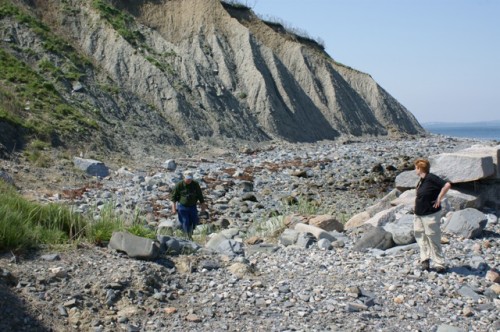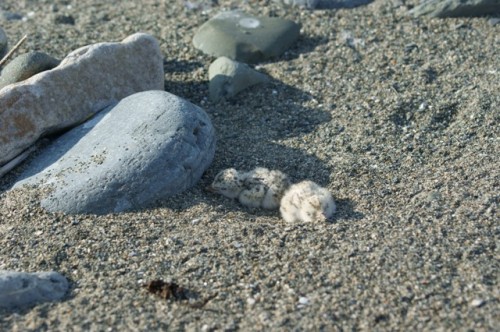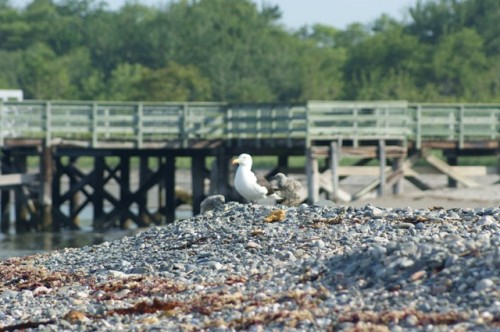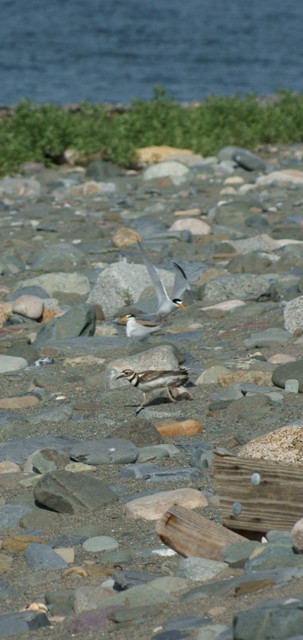After a slow start to the season, we’ve had two weeks of glorious weather and finished up May with a lot to show for our efforts!

The Graves, 5.25.11 CLT.
We kicked off the season for real on Wednesday, May 25th with a boat-based survey of the Outer Islands. Have you ever visited the Graves on a day like this?!? Incubating gull and cormorant numbers appear generally similar to previous years (see boat_counts_boha11.pdf, attached) – special thanks to Bob K. for observing and Pat for testing out electronic data collection with CyberTracker! Upon reaching the Outer Islands, we were greeted by three pair of American Oystercatchers just south of Calf Island. Based on observations during the rest of our loop, we believe that at least one pair is nesting on Calf and one pair on Middle Brewster. The third pair may have come over from Great Brewster (see 5/26 report) or there may be a second pair on Calf. We also spotted single adult AMOYs on intertidal rocks on Little Calf and Green Islands. There were still lots of adult male and immature male Common Eider ‘hanging around’ and 42 eider chicks were observed in small groups around the Graves, Middle, and Outer Brewster. (Although we missed our window to assess nesting eider this year, we will be tracking chick numbers beginning in mid-June.) Other items of note were 2 Harbor Seals on the rocks near Green Island, a juvenile Great Cormorant also on Green, and an adult GRCO on intertidal rocks off Outer Brewster – a future nesting waterbird species perhaps? On our way back to the dock on the 25th, we checked out the beach on Lovells where a few Least Terns were circling, but no nesting activity was noted. We also observed 2 AMOY feeding off Lovells and counted 14 nesting Herring Gulls and 15 nesting Great Black-backed Gulls on Gallops.

American Oystercatcher nest with two chicks on Great Brewster Island (5.26.11, CLT).
We headed back out on the 26th, taking advantage of the high tide and starting our morning with a visit to Snake Island in Winthrop where we observed 5 pair of American Oystercatchers and 5 pair of territorial Willets. In an effort to minimize disturbance, we did not search heavily for nests but territorial behavior was definitely apparent. Two Least Terns and 2 Common Terns were spotted in the area, but there was no indication of nesting. Also of note were Black-bellied Plover, White-winged Scoter, Killdeer, Ruddy Turnstones, Northern Rough-winged Swallows, and a Saltmarsh Sparrow (a species I had previously seen on Snake… though apparently Bob S. didn’t really believe me until he saw it for himself!) A visit to Great Brewster yielded 2 additional AMOY pairs who both nested on the landing beach where one pair has been found in previous years. The first nest held one egg and two brand new chicks being earnestly defended by their parents from interested gulls at the ready nearby. (My advice to nesting oystercatchers is – DON’T BUILD YOUR NEST NEAR A GULL COLONY – they never seem to listen to me….) Combined gull counts on Great Brewster resulted in 108 Herring Gull nests and 9 Great Black-backed Gull nests, most of which held 3 eggs. We also observed a Herring Gull with a green wing tag numbered 99, which appears to be a bird tagged as part of a DCR water supply study (see http://www.mass.gov/dcr/watersupply/watershed/study/index.htmfor more on this). A loop around Spectacle on our way back in yielded a whole lot of nothing, but it does not look like mowing has taken place yet, so that is great news for nesting birds.

Carl & Susan nest searching on Great Brewster (5.26.11, CLT).
This past week we spent Tuesday, May 31st conducting boat-based surveys in the Dorchester and Hingham areas. It appears to be a busy year for American Oystercatchers with a single adult spotted on Slate, 1 pair on Bumpkin, 1 pair on Sarah, 1 pair (with 2 chicks!) on Button, and 2 pairs with a possible 3rdon Sheep. Gull and Cormorant numbers were similar to previous years: Sarah (101 HERG, 11 GBBG, 85 DCCO), Ragged (1 HERG), Button (8 HERG, 2 GBBG), and Sheep (123 HERG, 4 GBBG, 15 DCCO). Cormorant numbers on both Sarah and Sheep are up from previous years and Herring Gulls seem to be down, but I haven’t yet had the chance to run through all the numbers. Also, although not our primary focus this year, wading bird colonies on Sarah and Sheep were quite active with all the expected species present. Finally, a landing on Rainsford turned up 2 MORE pairs of AMOY, 2 nesting GBBG, 1 nesting HERG, and approximately 11 territorial Spotted Sandpipers – an extremely consistent figure, though we had little luck with nest searching in 2010.

Sheep Island (5.31.11, CLT).
So for those of you keeping score at home, it appears we have at least 17 or 18 pairs of American Oystercatchers on territory in the islands, and we haven’t yet visited Thompson or Peddocks. So, we are on track for consistently high numbers again in 2011! We’ll be back out counting again the week of June 13th… See you then!
Read Full Post »


















